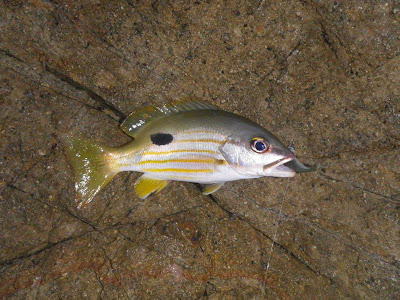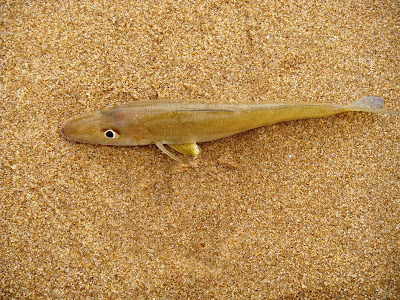Wednesday
Wednesday morning was windy again – a light south-easterly
with squalling showers. I walked round to the rocks on the eastern side of
Woody Head, at day break but the swell was still sending big sets crashing over
the top.
I gave up on the mornings fishing and drove off into Maclean
for breakfast and a chat with the helpful folk at Big River Bait & Tackle.
They confirmed the presence of a few Jewfish around the rocks but also pointed
out the weather would be my biggest obstacle for the next week.
I drove back to Iluka to find the birds working, out in the
calm waters off Woody Bay. They were staying too far off shore initially, but
gradually through the afternoon, they moved closer in. The netters showed up on
the beach at about 2.00 pm and as the whitebait came closer to the shore, they rowed
out with a long net to encircle them. They clearly got a good haul as it was
too heavy to pull up on the beach. They dragged it along through the water,
back to the boat ramp. Then they winched the bulging net up.
By about 2.30 pm the birds had followed another school in
close enough to cast at and a group of beach fisherman had come down to try and
catch a few. Suddenly the Salmon started to bash into the school, sending
Whitebait flying everywhere. I put on a
HALCO 65g Twisty and fired a cast over the boiling water. After a couple of
cranks I had a fish on. It was another solid Australian Salmon which put on a
great display of acrobatics. As I landed
it I saw my son was stuck into another but was turning into hard work as he
only had my light Nitro 6’6” spin rod. All along the beach the kids were
hooking up. The fish destroyed plenty of gear, but the patient fishermen
eventually landed a few decent sized Salmon. My son got his after an epic
battle. The fish had grabbed a GULP 4” Pearl Watermelon Minnow soft plastic,
attached to a 10lb leader. It was just under 50cm.
A few more casts with the HALCO Twisty failed to hook up so
I decided to try out some of the bigger DUO lures I had brought with me. The first
one that had been calling to me from the tackle box, is called the DUO Tide Vib
Slim. It is a 32g, 140 mm sinking Vibe lure. Once again, it is a beautifully
engineered lure with a very high quality finish. It is comparatively light for
its length but has a great action. Although it is very slim it still contains a
decent internal rattle. I think this
will prove to be big hit with the pelagic species – especially Tuna. I had it
in the Qantas colours – red head with a white body. I cast it about fifteen metres
off shore and played around until I found what I considered was the ideal
retrieve speed – which was fairly slow. I was using the Daiwa Demon Blood rock/
beach rod with a 30lb fluorocarbon leader.
It did not take long to catch a fish – on the fourth cast a
Salmon knocked it out of the water and then lunged at it again and was hooked.
It took plenty of line on a very determined initial run and then put in a few
leaps and rolls but eventually, I had it safely on the beach. It was a bit over
60cm long.
 I caught two more with this lure and then things went quiet
again. The soft plastics were still catching fish but I decided to try out
another DUO hard bodied lure – the Tide Minnow 105LD. The Tide Minnow is one of
their long established best sellers in Japan. It is also used extensively in
Europe to target Sea Bass. It looks like a fairly standard sinking minnow but its
internal ball bearing weighting system means it casts like a rocket.
Consistently with the rest of the range, it is finished to a very high standard.
I had it in a shiny purple colour with a dark underbody. It finds it rhythm
easily in the surf and it has a rolling body with a wiggling tail action. The
fish were thick and did not have to wait long. After about five casts another
Salmon slammed the lure just a few metres from the shore. I landed it and cast
out a few more times and then, bang I was on to another fish. This one was a
little larger and took longer to subdue, but eventually I got him up the beach.
I caught two more with this lure and then things went quiet
again. The soft plastics were still catching fish but I decided to try out
another DUO hard bodied lure – the Tide Minnow 105LD. The Tide Minnow is one of
their long established best sellers in Japan. It is also used extensively in
Europe to target Sea Bass. It looks like a fairly standard sinking minnow but its
internal ball bearing weighting system means it casts like a rocket.
Consistently with the rest of the range, it is finished to a very high standard.
I had it in a shiny purple colour with a dark underbody. It finds it rhythm
easily in the surf and it has a rolling body with a wiggling tail action. The
fish were thick and did not have to wait long. After about five casts another
Salmon slammed the lure just a few metres from the shore. I landed it and cast
out a few more times and then, bang I was on to another fish. This one was a
little larger and took longer to subdue, but eventually I got him up the beach.
 I should point out that these DUO lures have been provided
to me at no cost to test drive but as with all freebies, I will only write them
up positively if they catch fish. So far the DUO range have delivered fish for
me and so I am happy to recommend them. If you want to know more about them
contact Steve at http://www.swldistributions.com.au/.
I should point out that these DUO lures have been provided
to me at no cost to test drive but as with all freebies, I will only write them
up positively if they catch fish. So far the DUO range have delivered fish for
me and so I am happy to recommend them. If you want to know more about them
contact Steve at http://www.swldistributions.com.au/.
Suddenly, after an hour or so of mayhem, the fish were gone.
The birds were still circling and occasionally diving for the odd, wounded Whitebait,
but the Salmon had moved on or stopped eating. It had been a great session and
over the course of an hour I had witnessed five guys catch about 25 Australian
Salmon between them and lose plenty more. They may be awful to eat but they are
great fun to catch.















































